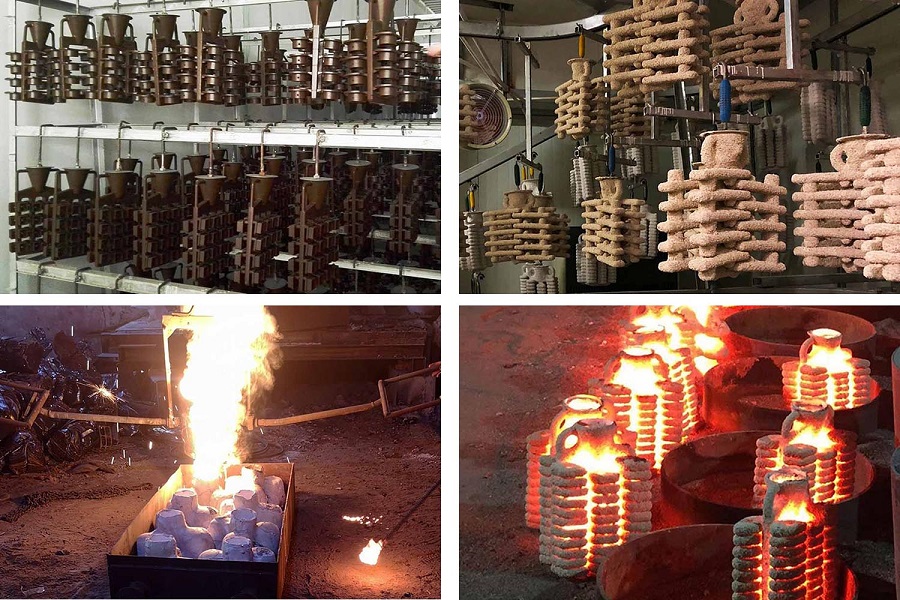
Alloy Steel Silica Sol Investment Casting Parts
Material: Alloy Steel Process: Silica Sol Investment Casting (Lost Wax Process) Weight: 6.20 kg Application: Agricultural Machinery
Custom Alloy Steel Silica Sol Investment Casting Parts from China with OEM services
Description
Custom Alloy Steel Silica Sol Investment Casting Parts from China with OEM services
Every steel is an alloy strictly, but not all steels are called "alloy steels". The main steels are iron (Fe) alloyed with carbon (C) (about 0.1% to 1%, depending on the grade). However, the term "alloy steel" is the standard term referring to steels with other alloying elements added deliberately. Common alloyants include manganese (the most common one), nickel, chromium, molybdenum, vanadium, silicon, and boron. Trace elements (or microelements) include aluminum, cobalt, copper, cerium, niobium, titanium, tungsten, tin, zinc, lead, and zirconium.
Alloying elements are added in alloy steel castings to reach certain mechanical properties. As a guideline, alloying elements are added in lower percentages (less than 5%) to increase strength or hardenability, or in larger percentages (over 5%) to achieve special properties, such as corrosion resistance or extreme temperature stability. Manganese, silicon, or aluminum are added during the steel making process to remove dissolved oxygen, sulfur and phosphorus from the molten metal.
The following is a range of improved properties in alloy steel castings (as compared to carbon steels): strength, hardness, toughness, wear resistance, corrosion resistance, hardenability, and hot hardness. Heat treatment maybe needed depending the requirements of the end-users.
▶ Casting Process of Stainless Steel
✔ Lost Wax Casting
Investment (lost wax) casting is a method of precision casting complex near-net-shape details using replication of wax patterns. It is a metal forming process that typically uses a wax pattern surrounded by a ceramic shell to make a ceramic mold. When the shell dries, the wax is melted away, leaving only the mold. Then the casting component is formed by pouring molten metal into the ceramic mold. Also called precision investment casting, lost wax casting could achieve complex forms with exceptional surface qualities for both small and large casting parts in a wide range of materials such as carbon steel, alloy steel, stainless steel...etc. lost wax casting offers tighter dimensional tolerances, better surface finishes, produces near-net shape parts which therefore require less machining and other processing, and allows for the steel casting of complex-geometry parts and intricate details such as casting marks and company logos.
Advantages of Investment Casting Components:
• Excellent and smooth surface finish
• Tight dimensional tolerances.
• Complex and intricate shapes with design flexibility
• Capability to cast thin walls therefore a lighter casting component
• Wide selection of cast metals and alloys (ferrous and non-ferrous)
• Draft is not required in the molds design.
• Reduce the need for secondary machining.
• Low material waste.
✔ Lost Foam Casting
Lost foam casting process produce near the near net shape casting parts with lost patterns made from expandable polystyrene, EPS. The EPS positive patterns are mounted to a casting system. After dressing, the pattern clusters are inserted into pouring vessels, which are then filled with unbound quartz sand. During casting, the patterns remain in the compacted sand mould.
Advantages of Lost Foam Castings:
• Greater design freedom in the construction of cast parts
• Small quantity is possible due to the layered structure of the pattern.
• Lower need for secondary machining with near net shape.
• High flexibility by short start up lead time.
• Longer EPS mould span life, thus lower average tool costs
✔ Vacuum Casting (V Process Casting)
Vacuum castings are the metal parts that are produced by the vacuum casting method, which is also called v process casting or vacuum molding casting. They are different from typical investment castings due to the technique used to create the molds. The process begins by placing a two-piece mold in a vacuum chamber. The vacuum then draws the molten metal into the mold. Finally, the casting is solidified in an oven and the mold is removed in order to release the final product.
▶ Capabilities of Cast Steel Components
• Max Size: 1,500 mm × 1000 mm × 500 mm
• Weight Range: 0.1 kg - 500 kg
• Annual Capacity: 5,000 tons - 6,000 tons
• Tolerances: On Request.
▶ How We Inspect the Cast Steel Components:
• Spectrographic and manual quantitative analysis
• Metallographic analysis
• Brinell, Rockwell and Vickers hardness inspection
• Mechanical property analysis
• Low and normal temperature impact testing
• Cleanliness inspection
• UT, MT and RT inspection
▶ Post-Casting Process
• Deburring & Cleaning
• Shot Blasting / Sand Peening
• Heat Treatment: Normalization, Quench, Tempering, Carburization, Nitriding
• Surface Treatment: Passivation, Anodizing, Electroplating, Hot Zinc Plating, Zinc Plating, Nickel Plating, Polishing, Electro-Polishing, Painting, GeoMet, Zintec
• Machining: Turning, Milling, Lathing, Drilling, Honing, Grinding,
▶ Application of Stainless Steel Castings:
• Building hardware
• Large Machinery Components
• Railway Freight Cars
• Marine Hardware
• Hydraulics Cylinders
• Heavy Duty Trucks
• Agricultural Equipment
To know better about our capabilities of lost wax casting, please click the following picture to turn to our page of Investment Casting Capabilities:

 русский
русский




